Effect of Snow Cover on Spring Soil Moisture Content in Key Agricultural Areas of Northeast China
Abstract
1. Introduction
2. Materials Methods
2.1. Study Sites
2.2. Data Sources
2.3. Data Analysis
2.3.1. Variance Analysis
2.3.2. Spatial Assessment Method
2.3.3. Correlation Analysis
2.3.4. Percentage Contribution
3. Results
3.1. Comparison of Spring Soil Moisture Content for the Songnen and Sanjiang Plains for 1983–2019
3.1.1. Comparison of Spring Soil Moisture Content at the 0–30 cm Soil Depth
3.1.2. Comparison of Spring Soil Moisture in Across Soil Layers
3.2. Factors Influencing the Spring Soil Moisture Content of the Songnen Plain and Sanjiang Plain
3.2.1. Factors Affecting Spring Soil Moisture at Different Soil Depths
3.2.2. Factors Affecting Soil Moisture at Different Depths for Each Month of Spring
3.3. Contribution by Snow-Cover Conditions on Spring Soil Moisture of the Songnen Plain
4. Discussion
5. Conclusions
Author Contributions
Funding
Institutional Review Board Statement
Informed Consent Statement
Data Availability Statement
Conflicts of Interest
References
- Li, P. Variation of snow water resources in northwest China from 1951 to 1997. Sci. China (Ser. D) 1999, S1, 63–69. (In Chinese) [Google Scholar]
- Jones, H.G.; Pomeroy, J.W.; Walker, D.A.; Hoham, R.W. Snow Ecology: An Interdisciplinary Examination of Snow-Covered Ecosystems; University Press: Cambridge, UK, 2001; pp. 103–120. [Google Scholar]
- Che, T.; Li, X. Spatial Distribution and Temporal Variation of Snow Water Resources in China during 1993–2002. J. Glaciol. Geocryol. 2005, 27, 64–67. (In Chinese) [Google Scholar]
- Barnett, T.P.; Adam, J.C.; Lettenmaier, D.P. Potential impacts of a warming climate on water availability in snowdominated regions. Nature 2005, 438, 303–309. [Google Scholar] [CrossRef]
- Fu, Q.; Hou, R.J.; Wang, Z.L.; Li, T.X. Soil moisture thermal interaction effects under snow cover during freezing and thawing period. Trans. Chin. Soc. Agric. Eng. 2015, 31, 101–107. (In Chinese) [Google Scholar] [CrossRef]
- Brown, R.D.; Robinson, D.A. Northern Hemisphere spring snow cover variability and change over 1922–2010 including an assessment of uncertainty. Cryosphere 2011, 5, 219–229. [Google Scholar] [CrossRef]
- McCabe, G.J.; Wolock, D.M. Long-term variability in Northern Hemisphere snow cover and associations with warmer winters. Clim. Change 2010, 99, 141–153. [Google Scholar] [CrossRef]
- Choi, G.; Robinson, D.A.; Kang, S. Changing Northern Hemisphere snow seasons. Climate 2010, 23, 5305–5310. [Google Scholar] [CrossRef]
- Derksen, C.; Brown, R. Spring snow cover extent reductions in the 2008–2012 period exceeding climate model projections. Geophys. Res. Lett. 2012, 39, 19504. [Google Scholar] [CrossRef]
- Zhang, Y.; Ning, M. Spatiotemporal variability of snow cover and snow water equivalent in the last three decades over eurasia. J. Hydrol. 2018, 559, 238–251. [Google Scholar] [CrossRef]
- Zhong, X.Y.; Zhang, T.J.; Kang, S.C.; Wang, J. Spatiotemporal variability of snow cover timing and duration over the Eurasian continent during 1966–2012. Sci. Total Environ. 2021, 750, 141670. [Google Scholar] [CrossRef]
- Takala, M.; Pulliainen, J.; Metsamaki, S.J.; Koskinen, J.T. Detection of Snowmelt Using Spaceborne Microwave Radiometer Data in Eurasia from 1979 to 2007. IEEE Trans. Geosci. Remote Sens. 2009, 47, 2996–3007. [Google Scholar] [CrossRef]
- Mioduszewski, J.R.; Rennermalm, A.K.; Robinson, D.A.; Wang, L. Controls on Spatial and Temporal Variability in Northern Hemisphere Terrestrial Snow Melt Timing, 1979–2012. J. Clim. 2015, 28, 2136–2153. [Google Scholar] [CrossRef]
- Zuo, Z.Y.; Zhang, R.H. Spatial-temporal variation of soil moisture in spring in Eastern China. Sci. China (Ser. D) 2008, 38, 1428–1437. (In Chinese) [Google Scholar]
- Vanand, L.A.F.; Laaha, G. Hydrological drought severity explained by climate and catchment characteristics. J. Hydrol. 2015, 526, 3–14. [Google Scholar]
- Shinoda, M. Climate memory of snow mass as soil moisture over central Eurasia. J. Geophys. Res.-Atmos. 2001, 106, 33393–33403. [Google Scholar] [CrossRef]
- Ren, X.Z.; Hu, C.S.; Zuo, H.J.; Yu, J. The effect of seasonal snow ablation on soil temperature. J. Arid Land Resour. Environ. 2010, 24, 122–125. (In Chinese) [Google Scholar]
- Niu, C.X.; Yang, J.M.; Zhang, B.; Liu, Z.H. Influence of seasonal accumulated snow melting on the moisture and heat of shallow soil layer in northern slope of Tianshan Mountain. J. Arid Land Resour. Environ. 2016, 30, 131–136. (In Chinese) [Google Scholar] [CrossRef]
- Qi, W.; Feng, L.; Liu, J.; Yang, H. Snow as an important natural reservoir for runoff and soil moisture in northeast China. J. Geophys. Res. Atmos. 2020, 125, e2020JD033086. [Google Scholar] [CrossRef]
- Douville, H.; Royer, J.F. Sensitivity of the Asian summer monsoon to an anomalous Eurasian snow cover within the Météo-France GCM. Clim. Dyn. 1996, 12, 449–466. [Google Scholar] [CrossRef]
- McNamara, J.P.; Chandler, D.; Seyfried, M.; Achet, S. Soil moisture states, lateral flow, and streamflow generation in a semi-arid, snowmelt-driven catchment. Hydrol. Process. 2005, 19, 4023–4038. [Google Scholar] [CrossRef]
- Zhang, Y.; Haimidan, H.; Gulimire, H.; Liu, Q.Q.; Su, L.T. The influence of snowmelt on soil temperature and moisture in different freezing-thawing stages on the north slope of Tianshan mountain. Acta. Ecol. Sin. 2020, 40, 1602–1609. (In Chinese) [Google Scholar] [CrossRef]
- Laudon, H.; Seibert, J.; Kohler, S.; Bishop, K. Hydrological flow paths during snowmelt: Congruence between hydrometric measurements and oxygen 18 in meltwater, soil water, and runoff. Water Resour. Res. 2004, 40, W03102. [Google Scholar] [CrossRef]
- Flerchinger, G.N.; Cooley, K.R.Y.; Deng, Y. Impacts of spatially and temporally varying snowmelt on subsurface flow in a mountainous watershed: 1. Snowmelt simulation. Hydrol. Sci. J. 1994, 39, 507–520. [Google Scholar] [CrossRef]
- Wang, M.; He, F.; Zhu, H.; Ji, Y.H. Spatial and temporal distribution of soil moisture in main agricultural areas of Heilongjiang Province under the background of climate change. Heilongjiang Meteorol. 2017, 34, 24–25. (In Chinese) [Google Scholar]
- Zhu, H.X.; Gong, L.J.; Qu, H.H.; Lv, J.J.; Wang, L.L.; Li, B.C.; Ji, Y.H.; Yan, P.; Wang, Q.J.; Jiang, L.N. The evolution of summer soil moisture from 1981 to 2010 in Heilongjiang province. J. Meteorol. Environ. 2012, 28, 34–39. (In Chinese) [Google Scholar]
- Wang, D.; Nan, R.; Han, J.J.; Gao, Y.G.; Li, X.F.; Sun, Y.K. Characteristics of soil humidity and its sensitivity to temperature andprecipitation in Heilongjiang province. J. Meteorol. Environ. 2012, 28, 49–53. (In Chinese) [Google Scholar]
- Han, J.J.; Gao, Y.G.; Nan, R.; Cao, W.D. Characteristics of Soil Moisture Variation in Main Agricultural Areas of Heilongjiang Province from 1984 to 2005. Chin. J. Agrometeorol. 2009, 30, 41–44. (In Chinese) [Google Scholar]
- Chang, J.; Wang, G.X.; Gao, Y.H.; Wang, Y.B. Impacts of snow cover change on soil water-heat processes of swamp and meadow in Permafrost Region, Qinghai–Tibetan Plateau. Acta Ecol. Sin. 2012, 32, 7289–7301. (In Chinese) [Google Scholar] [CrossRef][Green Version]
- Pan, F.F.; Nieswiadomy, M. Estimating daily root-zone soil moisture in snow-dominated regions using an empirical soil moisture diagnostic equation. J. Hydrol. 2016, 542, 938–952. [Google Scholar] [CrossRef]
- Potopova, V.; Boroneant, C.; Mozny, M.; Soukup, J. Driving role of snow cover on soil moisture and drought development during the growing season in the Czech Republic. Int. J. Climatol. 2016, 36, 3741–3758. [Google Scholar] [CrossRef]
- Liang, S.; Li, X.; Zheng, X.; Jiang, T.; Jiang, T.; Li, X.J.; Qiao, D.J. Effects of winter snow cover on spring soil moisture based on remote sensing data product over farmland in northeast china. Remote Sens. 2020, 12, 2716. [Google Scholar] [CrossRef]
- Qi, D.H.; Zhou, B.T.; Xiao, C.D. Progress in studies of cryospheric changes an their impacts on climate of China. Acta Meteorol. Sin. 2014, 72, 869–879. [Google Scholar] [CrossRef]
- Meehl, G.A. Influence of the land surface in the Asian summer monsoon—External conditions versus internal feedbacks. J. Clim. 1994, 7, 1033–1049. [Google Scholar] [CrossRef]
- Santanello, J.A.; Peters-Lidard, C.D.; Kumar, S.V.; Alonge, C.; Tao, W.K. A modeling and observational framework for diagnosing local land-atmosphere coupling on diurnal time scales. J. Hydrometeorol. 2009, 10, 577–599. [Google Scholar] [CrossRef]
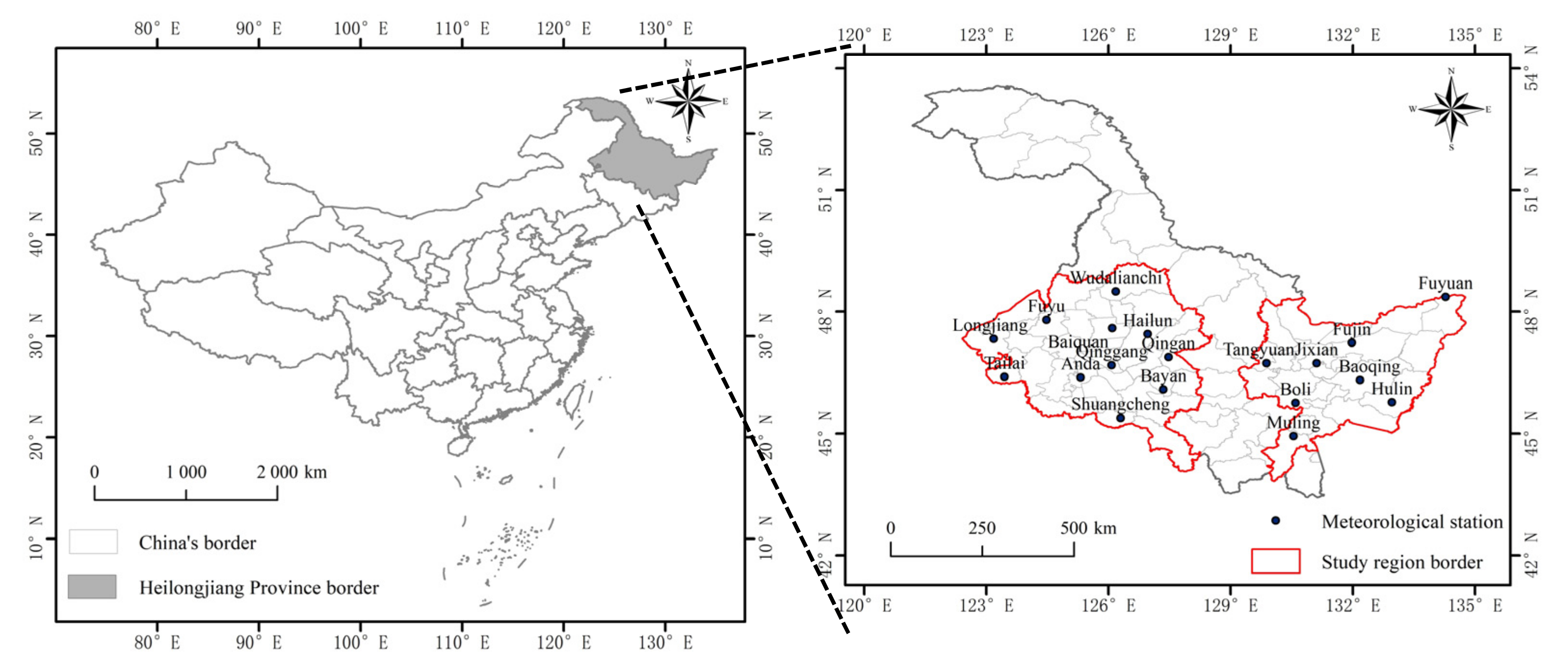
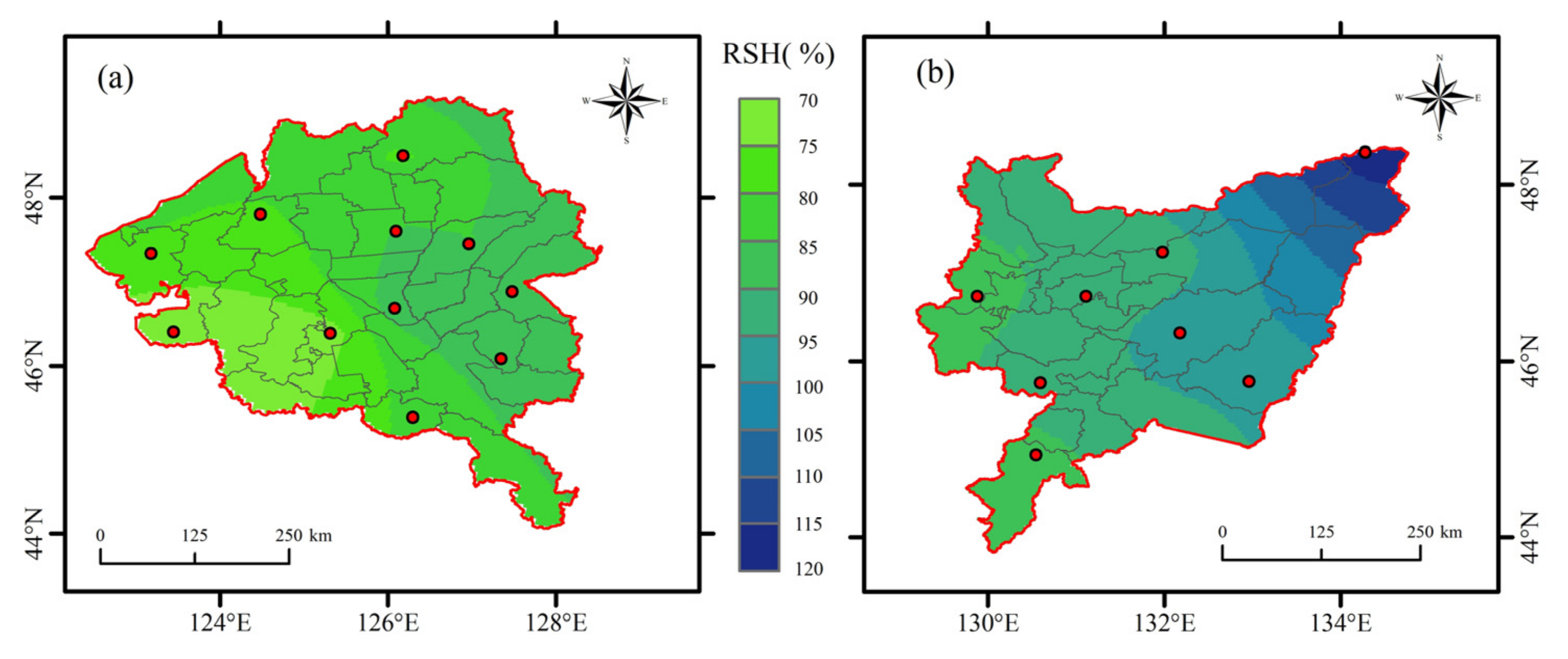
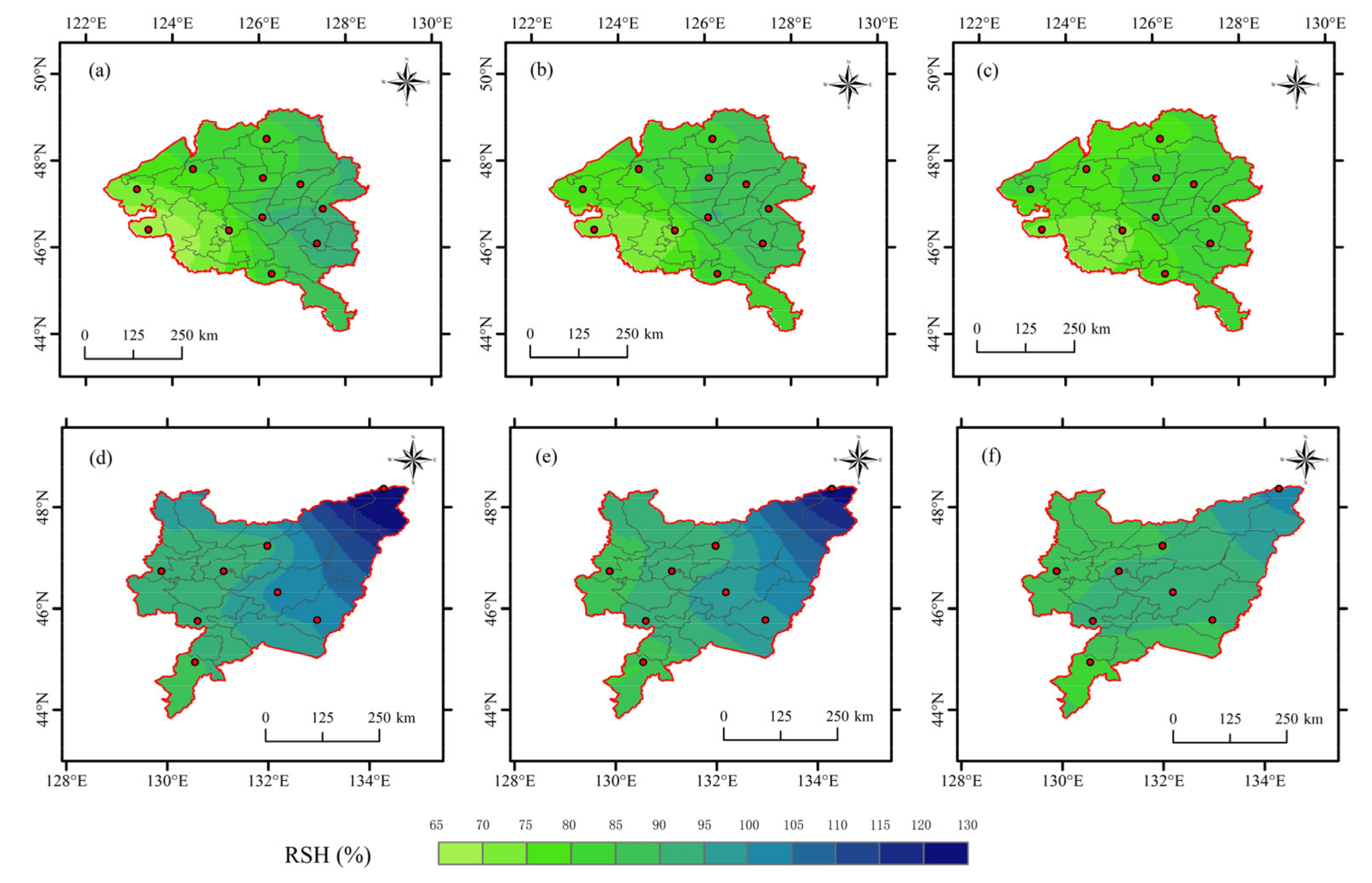
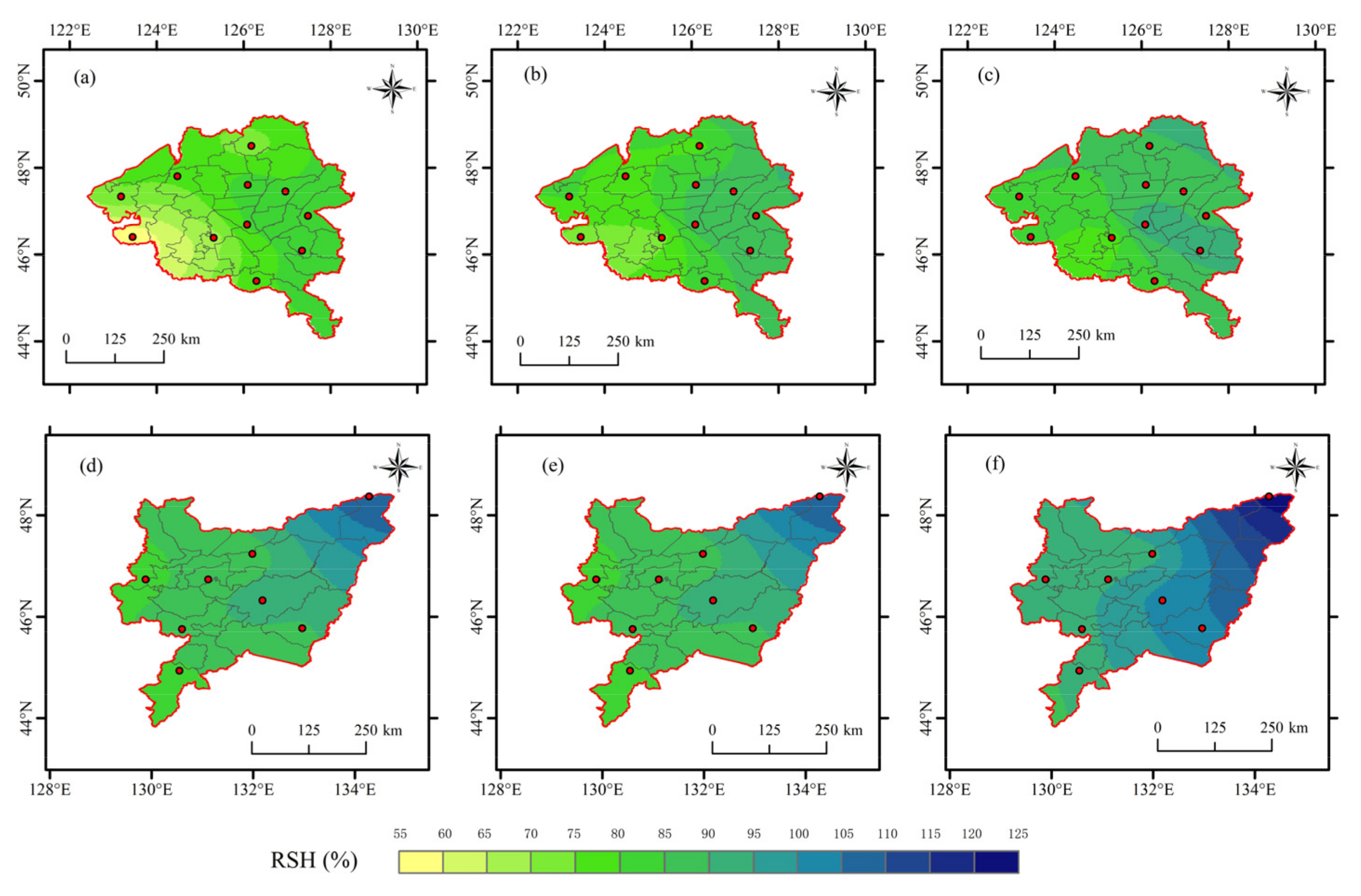
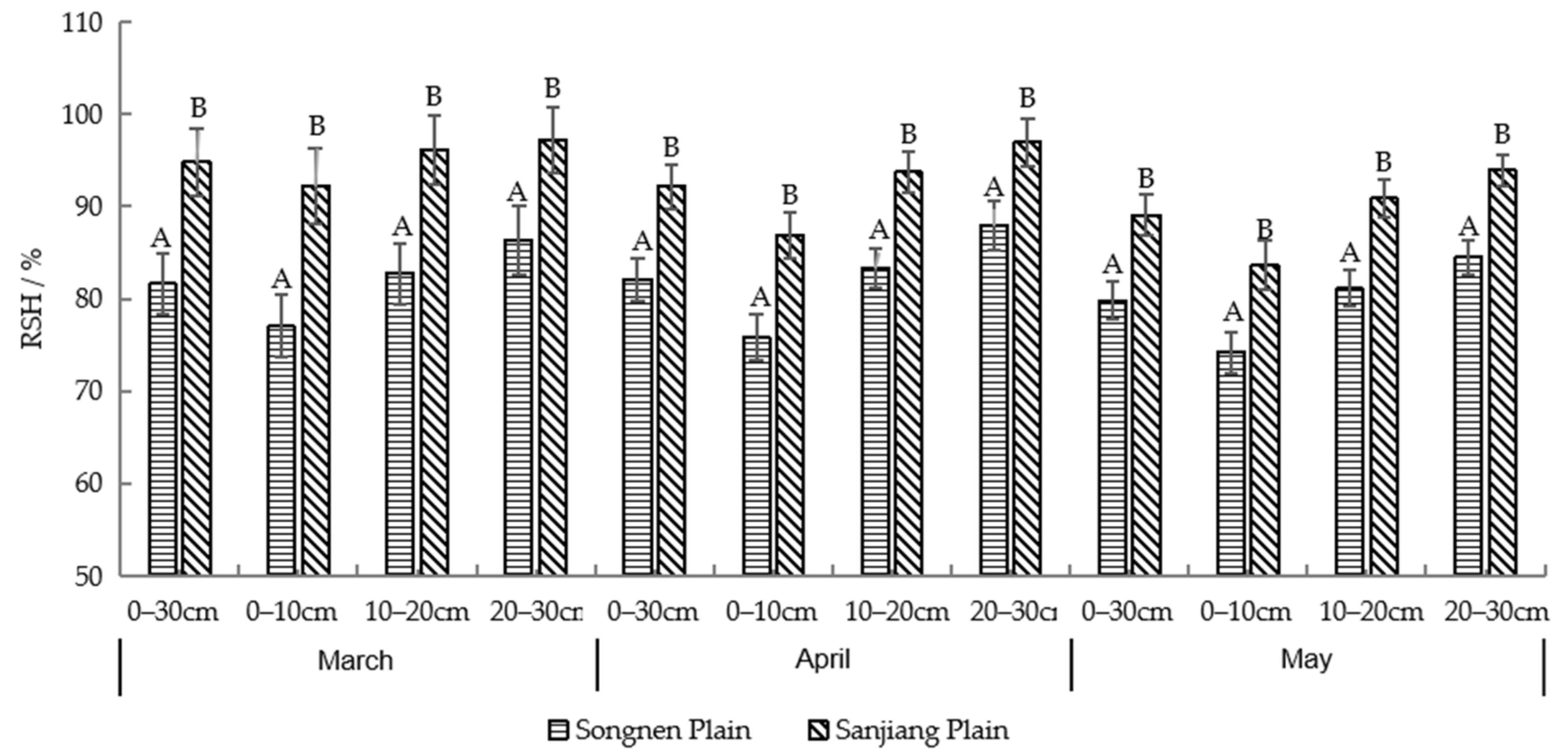
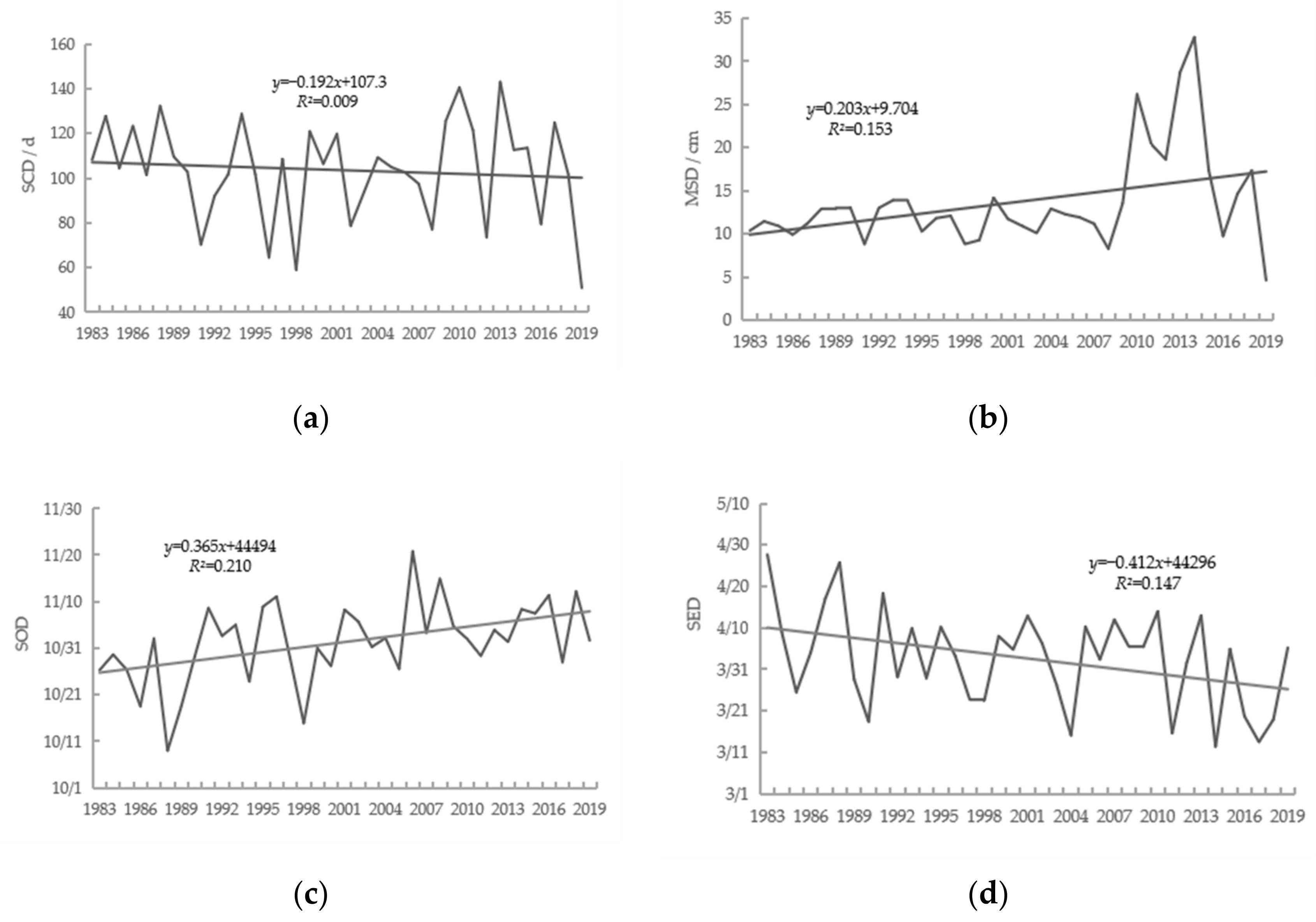
| Area | Layer | T | P | ST | WS | SD | PPA | SCD | MSD | SDD | SOD |
|---|---|---|---|---|---|---|---|---|---|---|---|
| Songnen Plain | 0–30 cm | −0.455 ** | 0.135 | −0.093 | 0.168 | 0.179 | 0.656 ** | 0.484 ** | 0.28 | −0.461 ** | 0.176 |
| 0–10 cm | −0.420 ** | 0.283 | 0.122 | −0.013 | 0.057 | 0.628 ** | 0.523 ** | 0.395 * | −0.386 * | 0.153 | |
| 10–20 cm | −0.435 ** | 0.152 | −0.05 | 0.119 | 0.149 | 0.660 ** | 0.469 ** | 0.284 | −0.424 ** | 0.156 | |
| 20–30 cm | −0.454 ** | −0.024 | −0.309 | 0.352 * | 0.292 | 0.611 ** | 0.414 * | 0.148 | −0.511 ** | 0.195 | |
| Sanjiang Plain | 0–30 cm | −0.204 | 0.139 | −0.189 | 0.122 | −0.148 | 0.595 ** | 0.229 | −0.047 | 0.013 | −0.064 |
| 0–10 cm | −0.238 | 0.253 | −0.132 | 0.092 | −0.205 | 0.566 ** | 0.282 | 0.026 | −0.004 | −0.100 | |
| 10–20 cm | −0.169 | 0.068 | −0.200 | 0.146 | −0.119 | 0.597 ** | 0.178 | −0.097 | 0.032 | −0.043 | |
| 20–30 cm | −0.182 | 0.074 | −0.221 | 0.117 | −0.099 | 0.566 ** | 0.200 | −0.071 | 0.011 | −0.041 |
| Area | Month | Layer | T | P | ST | WS | SD | PPA | SCD | MSD | SDD | SOD |
|---|---|---|---|---|---|---|---|---|---|---|---|---|
| Songnen Plain | March | 0–10 cm | −0.282 | −0.195 | 0.062 | −0.147 | 0.145 | 0.621 ** | 0.547 ** | 0.230 | −0.390 * | −0.062 |
| 10–20 cm | −0.278 | −0.210 | −0.095 | 0.000 | 0.138 | 0.657 ** | 0.445 ** | 0.152 | −0.504 ** | 0.014 | ||
| 20–30 cm | −0.295 | −0.283 | −0.292 | 0.195 | 0.099 | 0.600 ** | 0.372 * | 0.037 | −0.505 ** | 0.112 | ||
| April | 0–10 cm | −0.380 * | 0.267 | 0.159 | 0.089 | −0.041 | 0.507 ** | 0.479 ** | 0.471 ** | −0.314 | 0.362 * | |
| 10–20 cm | −0.427 ** | 0.136 | −0.083 | 0.179 | 0.022 | 0.558 ** | 0.461 ** | 0.363 * | −0.343 * | 0.267 | ||
| 20–30 cm | −0.367 * | 0.010 | −0.313 | 0.410 * | 0.121 | 0.567 ** | 0.441 ** | 0.181 | −0.540 ** | 0.231 | ||
| May | 0–10 cm | −0.455 ** | 0.688 ** | 0.137 | −0.084 | −0.397 * | 0.410 * | 0.239 | 0.318 | −0.247 | 0.155 | |
| 10–20 cm | −0.384 * | 0.537 ** | 0.052 | −0.017 | −0.230 | 0.532 ** | 0.346 * | 0.303 | −0.235 | 0.216 | ||
| 20–30 cm | −0.405 * | 0.415 * | −0.112 | 0.109 | −0.070 | 0.530 ** | 0.349 * | 0.271 | −0.364 * | 0.252 | ||
| Sanjiang Plain | March | 0–10 cm | −0.192 | 0.094 | −0.236 | 0.096 | 0.119 | 0.543 ** | 0.352 * | −0.050 | −0.175 | −0.138 |
| 10–20 cm | −0.057 | 0.108 | −0.165 | 0.076 | 0.002 | 0.590 ** | 0.192 | −0.147 | −0.020 | −0.097 | ||
| 20–30 cm | −0.118 | 0.158 | −0.199 | 0.052 | −0.069 | 0.576 ** | 0.200 | −0.109 | 0.033 | −0.046 | ||
| April | 0–10 cm | −0.188 | −0.070 | 0.056 | 0.040 | −0.217 | 0.501 ** | 0.275 | 0.182 | 0.122 | 0.104 | |
| 10–20 cm | −0.092 | −0.309 | −0.095 | 0.031 | 0.027 | 0.563 ** | 0.160 | 0.004 | 0.052 | 0.053 | ||
| 20–30 cm | 0.044 | −0.316 | −0.077 | 0.052 | 0.089 | 0.489 ** | 0.173 | −0.077 | −0.078 | −0.021 | ||
| May | 0–10 cm | −0.454 ** | 0.616 ** | 0.018 | 0.034 | −0.427 ** | 0.271 | 0.009 | −0.002 | 0.141 | −0.159 | |
| 10–20 cm | −0.513 ** | 0.503 ** | −0.167 | 0.194 | −0.462 ** | 0.363 * | 0.095 | −0.050 | 0.106 | −0.020 | ||
| 20–30 cm | −0.410 * | 0.497 ** | −0.034 | −0.014 | −0.433 ** | 0.385 * | 0.152 | 0.079 | 0.106 | −0.030 |
| Month | Layer | Multiple Linear Regression Equation | R2 | DF | SE | SE of Regression Coefficient | ||||
|---|---|---|---|---|---|---|---|---|---|---|
| March | 0–10 cm | y = 0.469**xPPA + 0.324*xSCD − 0.213xSOD | 0.552 ** | 34 | 7.87 | PPA | SCD | SOD | ||
| 0.039 | 0.064 | 0.159 | ||||||||
| 10–20 cm | y = 0.536**xPPA − 0.361**xSOD + 0.158xSCD | 0.604 ** | 34 | 7.12 | PPA | SOD | SCD | |||
| 0.035 | 0.144 | 0.058 | ||||||||
| 20–30 cm | y = 0.497**xPPA − 0.388**xSOD + 0.091xSCD | 0.528 ** | 34 | 8.87 | PPA | SOD | SCD | |||
| 0.044 | 0.179 | 0.072 | ||||||||
| April | 0–10 cm | y = 0.370*xPPA + 0.285xSDD + 0.240xMSD + 0.172xSCD − 0.012xT | 0.491 ** | 31 | 6.33 | PPA | SDD | MSD | SCD | T |
| 0.031 | 0.104 | 0.071 | 0.062 | 0.863 | ||||||
| 10–20 cm | y = 0.408**xPPA − 0.285xT − 0.248xSOD + 0.098xMSD + 0.083xSCD | 0.508 ** | 31 | 5.23 | PPA | T | SOD | MSD | SCD | |
| 0.026 | 0.63 | 0.109 | 0.059 | 0.054 | ||||||
| 20–30 cm | y = 0.377**xPPA − 0.369**xSOD − 0.243xT + 0.175xWS + 0.125xSCD | 0.629 ** | 31 | 5.77 | PPA | SOD | T | WS | SCD | |
| 0.029 | 0.132 | 0.69 | 1.853 | 0.053 | ||||||
| May | 0–10 cm | y = 0.715**xP + 0.313**xPPA − 0.204xT + 0.178xSD | 0.643 ** | 32 | 4.67 | P | PPA | T | SD | |
| 0.047 | 0.022 | 0.655 | 0.036 | |||||||
| 10–20 cm | y = 0.439**xP + 0.427**xPPA − 0.134xT + 0.132xSCD | 0.559 ** | 32 | 4.57 | P | PPA | T | SCD | ||
| 0.034 | 0.023 | 0.636 | 0.037 | |||||||
| 20–30 cm | y = 0.408**xPPA + 0.283*xP − 0.185xSOD − 0.176xT + 0.100xSCD | 0.507 ** | 31 | 4.72 | PPA | P | SOD | T | SCD | |
| 0.024 | 0.035 | 0.097 | 0.667 | 0.039 | ||||||
| March | April | May | |||||||
|---|---|---|---|---|---|---|---|---|---|
| Layer (cm) | 0–10 | 10–20 | 20–30 | 0–10 | 10–20 | 20–30 | 0–10 | 10–20 | 20–30 |
| PPA | 25.75 | 30.71 | 26.89 | 16.82 | 18.46 | 18.41 | 14.26 | 21.09 | 17.93 |
| SOD | 11.68 | 20.67 | 20.99 | - | 11.25 | 18.00 | - | - | 8.12 |
| SCD | 17.77 | 9.02 | 4.92 | 7.84 | 3.74 | 6.10 | - | 6.51 | 4.42 |
| MSD | - | - | - | 10.94 | 4.43 | - | - | - | - |
| SDD | - | - | - | 12.97 | - | - | - | - | - |
| T | - | - | - | 0.54 | 12.92 | 11.84 | 9.32 | 6.61 | 7.76 |
| WS | - | - | - | - | - | 8.56 | - | - | - |
| P | - | - | - | - | - | - | 32.61 | 21.69 | 12.46 |
| SD | - | - | - | - | - | - | 8.11 | - | - |
| Songnen Plain | Sanjiang Plain | |
|---|---|---|
| T | 5.54 °C a | 5.40 °C a |
| P | 69.48 mm a | 99.16 mm b |
| ST | −2.88 °C a | −1.86 °C b |
| WS | 3.63 m/s a | 3.38 m/s b |
| SD | 745.1 h a | 677.7 h b |
Publisher’s Note: MDPI stays neutral with regard to jurisdictional claims in published maps and institutional affiliations. |
© 2022 by the authors. Licensee MDPI, Basel, Switzerland. This article is an open access article distributed under the terms and conditions of the Creative Commons Attribution (CC BY) license (https://creativecommons.org/licenses/by/4.0/).
Share and Cite
Pan, M.; Zhao, F.; Ma, J.; Zhang, L.; Qu, J.; Xu, L.; Li, Y. Effect of Snow Cover on Spring Soil Moisture Content in Key Agricultural Areas of Northeast China. Sustainability 2022, 14, 1527. https://doi.org/10.3390/su14031527
Pan M, Zhao F, Ma J, Zhang L, Qu J, Xu L, Li Y. Effect of Snow Cover on Spring Soil Moisture Content in Key Agricultural Areas of Northeast China. Sustainability. 2022; 14(3):1527. https://doi.org/10.3390/su14031527
Chicago/Turabian StylePan, Mingxi, Fang Zhao, Jingyan Ma, Lijuan Zhang, Jinping Qu, Liling Xu, and Yao Li. 2022. "Effect of Snow Cover on Spring Soil Moisture Content in Key Agricultural Areas of Northeast China" Sustainability 14, no. 3: 1527. https://doi.org/10.3390/su14031527
APA StylePan, M., Zhao, F., Ma, J., Zhang, L., Qu, J., Xu, L., & Li, Y. (2022). Effect of Snow Cover on Spring Soil Moisture Content in Key Agricultural Areas of Northeast China. Sustainability, 14(3), 1527. https://doi.org/10.3390/su14031527





